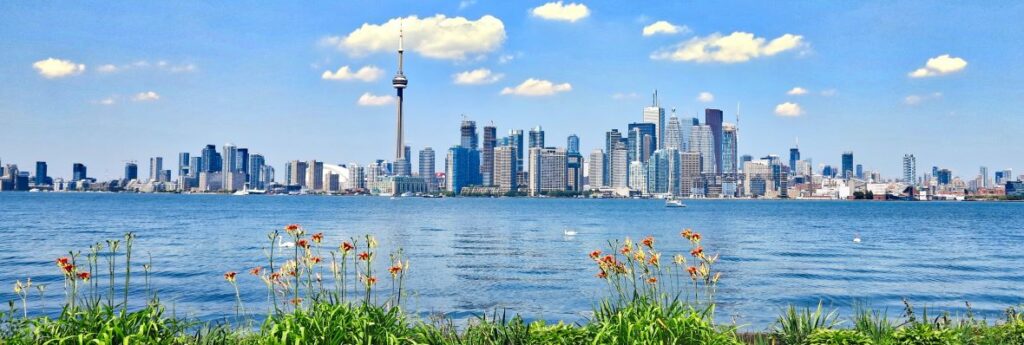Visitors injected billions of dollars into Toronto’s economy last year, a new study finds, but tourists have yet to return to pre-pandemic levels amid signs of slowing growth. Some 26.5 million visitors arrived in 2023 and spent $8.4 billion – the bulk of it on hotels, restaurants and transportation – according to a report from Tourism Economics.
However, tourist numbers fell short of the high-water mark in 2019, when 28 million people descended on the city, according to tourism organization Destination Toronto, which commissioned the study.
Last year, 88% of visitors were Canadian, while nearly 7% came from the US and 4.5% from overseas. The percentages for the latter two were higher before the pandemic.
While spending in 2023 slightly surpassed pre-pandemic levels, much of that owes to inflation, said report author Tariq Khan.
Growth also appears to be sputtering. Hotel bookings in May fell from a year earlier, said Destination Toronto CEO Andrew Weir, a sign of a possible pullback by visitors this summer. “The recovery is still far from complete, and uneven,” he said in an interview.
“Revenge travel was great for a while,” Weir said, referring to the wave of tourism that followed two years of pent-up demand caused by the COVID-19 pandemic. “It’s not a straight line. Growth is returning but it’s slowing.”
However, the industry hopes at least one event this year might kick off something of a new era.
“Taylor Swift,” said Weir.
The pop superstar is slated to swoop into town for a six-night run at the Rogers Centre this November. Hotel reservations for the month – typically a blank space for bookings – were up 300% as of early June compared with a year ago, he said. “Any guesses why?”
The Taylor Swift effect can be almost too much for some downtowns to bear.
“We’re already well and truly into preparing the infrastructure for that,” said Coun. Shelley Carroll, Toronto’s budget chief. “It can kind of upend your core business district if that’s where your venue is.”
Carroll cited the extra resources required – emergency services, for example – to handle the crowds “as hotels fill up.”
But even legions of Swifties may not be able to counter the tourism drag caused by inflation and higher interest rates.
“Family budgets are getting squeezed and that translates into (less) discretionary spending, which includes tourism,” Weir said.
A big drop in visitors from China – Toronto’s No. 1 tourism market with more than 300,000 arrivals in 2019 – has also dented the figures. The steep drop-off stems from China’s decision to not add Canada to its list of countries authorized as travel spots for tour groups, even as the US, UK, Australia and others made it onto the list last summer.
“It allows groups to conduct meetings here and companies to travel here,” Weir said, pointing to “diplomatic issues” that have kept Canada from becoming an approved destination.
“These were high-yield travellers,” he added. “If you’re going to fly 12 hours, you stay long and you do a lot at the destination when you arrive.”
Nonetheless, leisure tourism has rebounded more than the corporate kind. The sluggish return of trade conventions and business travel more broadly accounts for much of the plateauing in tourism this year.
Destination Toronto facilitated 71 major conferences and events last year, well below 2018’s 100-plus gatherings. The events in 2023 drew 290,000 business delegates – many of them visitors – who spent about $400 million, which speaks to conventions’ outsized economic contribution, Weir said. But that figure pales in comparison with the $800 million in spending from six years earlier.
“Some of the major meetings just haven’t fully come back,” he said.
Canada’s more gradual wind-down of health and travel restrictions in the years following the onset of the pandemic could have also cost it some major event bookings, since large conventions are booked up to seven years in advance.
“A lot of the meetings that are happening in ’23, ’24, ’25, ’26, they were booked in 2021. And in 2021, no American meeting planner was choosing Canada. Our border was closed,” said Weir.
Meanwhile, individual business travellers and smaller corporate groups have opted increasingly for video calls over expensive, time-sucking on-site visits.
“That sort of thing has changed forever,” Weir said.
The study found tourism sustained nearly 47,300 jobs directly – and roughly 20,000 more indirectly – in Toronto last year, making it all the more essential for operators to tap new markets and expand the sector.
“If we’re only selling within the Toronto or Ontario economy, then you’re not growing, you’re just kind of moving money around within it,” Weir said.

